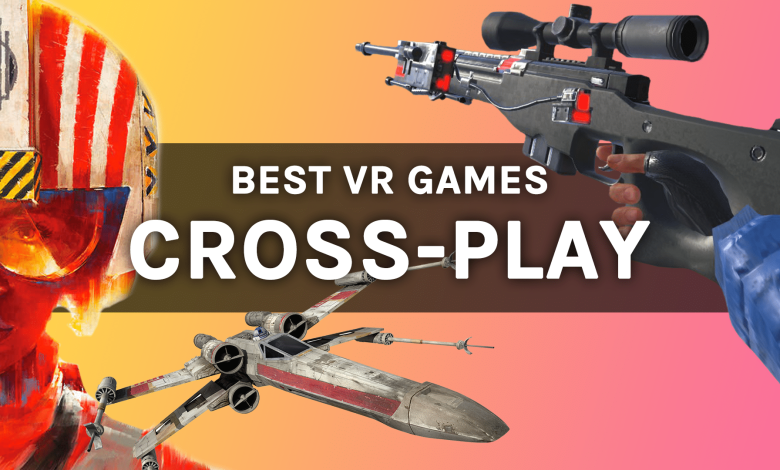
Virtual reality has revolutionized the way we perceive multiplayer gaming. It’s no longer just about sitting on a couch with friends or joining a server on a flat screen. Instead, VR drops you directly into another world where you can interact, strategize, and laugh as if you’re standing next to someone in real life.
But here’s the catch—VR is expensive, and not everyone owns the same headset. That’s where crossplay comes in. It bridges the gap between platforms, letting people with different devices still share the same immersive experience. Without crossplay, the VR community risks being divided into smaller, isolated groups. With it, gamers can enjoy broader communities, bigger competition pools, and deeper social connections.
So, what are the Best Multiplayer VR Games With Crossplay Support? Let’s break it down.
Why Crossplay Matters
Crossplay isn’t just a technical feature—it’s the glue that holds diverse gaming communities together. Imagine you bought a Meta Quest 3 while your best friend invested in a PlayStation VR2. Without crossplay, both of you would be locked into separate ecosystems. That’s frustrating and isolating.
Crossplay solves this by enabling different platforms to communicate seamlessly with each other. It makes multiplayer VR gaming less about which hardware you own and more about the quality of the experience. It’s like when Xbox and PlayStation finally agreed to let Fortnite players face off. Suddenly, gaming stopped being about silos and began to focus on inclusivity.
VR needs this even more because the market is still small compared to traditional gaming. A larger combined player pool means faster matchmaking, healthier competition, and more lasting communities.
Overcoming Hardware Barriers for Inclusive VR Gaming

The VR landscape is fragmented. Oculus has its Quest line, Sony has PSVR, Valve champions PC VR, and companies like Pico are trying to join the race. Each comes with unique controllers, specs, and tracking systems. That creates hurdles for developers.
Crossplay becomes the equalizer. Instead of designing games locked into a single hardware ecosystem, studios can create titles that unite these devices under a shared, unified experience. Think of it as a universal language translation for VR headsets. Sure, a Quest might not have the same graphics power as a high-end PC running Valve Index, but crossplay ensures that both can still enjoy the same game together.
Of course, compromises happen. Graphical fidelity may scale down for standalone devices. Features like haptic triggers on PSVR2 controllers might not transfer perfectly. Yet, most players don’t care as long as they can play with friends. That human connection outweighs minor technical sacrifices.
Key Features for a Great Crossplay Experience
For crossplay to feel seamless, a game needs more than just “platform compatibility.”
First, matchmaking should work quickly. Nobody wants to sit in a lobby for 20 minutes waiting for opponents. Games like Population: One keep queues short by blending users from Quest, Rift, and PC VR.
Second, communication tools must feel natural. VR thrives on presence, so voice chat should be crisp and intuitive. Body language replication, such as nodding one’s head or making hand gestures, also adds authenticity.
Third, updates need synchronization. Nothing kills momentum like one platform getting a patch weeks later, splitting the community. Studios that prioritize simultaneous rollouts earn player trust.
Lastly, controls should feel balanced. A PC VR player with full tracking shouldn’t have an unfair advantage over someone on a standalone headset. Innovative design keeps competition fun and fair.
The Best Multiplayer VR Games With Crossplay Support
Here’s the part you’ve been waiting for—the actual games. These titles prove that crossplay isn’t just possible; it’s thriving.
Population: One
This is VR’s answer to Fortnite. You drop into a massive map, climb walls, fly with your arms spread like wings, and fight to survive. The magic here isn’t just the gameplay mechanics but the way Population: One connects players across Quest, Rift, and SteamVR.
When BigBox VR launched it, skeptics doubted it would sustain a healthy player base. Crossplay changed that. Suddenly, Quest users could battle PC gamers without friction. It kept matchmaking quick and lively. Even today, you can still find active lobbies thanks to that design choice.
Rec Room
If the metaverse had a starter kit, it would resemble Rec Room. It’s not one game but a social hub filled with activities—paintball, dodgeball, quests, and even player-created rooms. What makes it special is accessibility. You can play it on VR headsets, as well as on phones or consoles.
That means you could be in VR playing charades with someone on their iPad and another friend on PlayStation. It breaks every barrier and shows how crossplay builds communities bigger than just VR.
VRChat
The wild west of VR social interaction, VRChat thrives because of its player-created worlds and avatars. It’s less about traditional “games” and more about human interaction. One night you might be in a virtual karaoke bar; the next, you’re exploring a haunted mansion with strangers.
Crossplay makes it even richer. PC VR users, Quest players, and desktop gamers mingle in the same virtual spaces. Some events attract thousands, creating a festival-like atmosphere that would be impossible without crossplay.
No Man’s Sky VR
When No Man’s Sky launched, it was infamous for not living up to promises. Fast forward, and the developers have turned it into one of the most ambitious space exploration titles ever. With VR support and crossplay across PC, PlayStation, and Xbox, the universe finally feels alive.
You can hop into your ship on PSVR2 while your friend mines resources on PC VR. Together, you explore galaxies in ways that were once science fiction. That sense of scale only works because of crossplay.
Arizona Sunshine 2
The zombie apocalypse feels different when you’re inside it. Arizona Sunshine 2 builds upon its predecessor with enhanced graphics, co-op campaigns, and cross-play support. Fighting hordes of zombies alongside a friend using another headset adds tension and fun in equal measure.
The game thrives because it doesn’t isolate players by platform. Everyone fights for survival together, which mirrors the spirit of zombie fiction itself—unity in chaos.
Niche but Notable Crossplay Gems
Some VR titles might not dominate headlines, but they still showcase brilliant gameplay integration. Demeo, for instance, brings tabletop RPGs into VR, allowing PC and flat-screen players to join in. Echo VR—before Meta retired it—proved that futuristic sports could bring diverse players together.
These smaller experiences often push innovation. They don’t always attract millions, but they keep the spirit of experimentation alive in the VR gaming world.
Games with VR and Non-VR Player Crossplay
Crossplay doesn’t have to be limited to headset users. Some games allow VR and non-VR players to share the same space, which opens up opportunities for larger communities.
Phasmophobia, for example, supports VR and PC crossplay, letting ghost hunters decide whether to be fully immersed or stick to traditional controls. Star Trek: Bridge Crew does something similar, letting flat-screen players command starships alongside VR captains.
These hybrid experiences matter because they give hesitant players a way in. Not everyone wants to invest in VR hardware immediately, but with crossplay, they don’t feel excluded.
Beyond VR Headsets
Crossplay isn’t just about mixing different headsets. It’s also about linking VR with consoles, PCs, and even mobile devices. Rec Room and Among Us VR show how blending ecosystems broadens accessibility.
The future might see even tighter integration. Imagine streaming VR experiences through cloud gaming platforms, where the headset serves as a viewer, and the heavy lifting occurs elsewhere. That would make crossplay not just a feature but the default expectation.
Tips for a Seamless Crossplay Experience
Crossplay works best when players set themselves up for success.
First, check your internet connection. VR requires stable bandwidth since lag feels much more disruptive when you’re immersed in a virtual world.
Second, keep your hardware updated. Firmware mismatches between platforms can cause issues. Third, use a good headset with a good fit and audio setup—clear communication makes multiplayer gaming smoother.
Finally, join communities outside the game itself. Discord servers, Reddit groups, or in-game clans can enhance your experience by connecting you to active players who know the ropes.
The Future of VR Crossplay

Crossplay in VR is still evolving. Developers recognize its value, but implementation varies. As VR hardware becomes more standardized, crossplay will likely become less of a luxury and more of a default.
Cloud computing and 5G may further enhance this by reducing reliance on hardware power. If that happens, even low-cost headsets could play alongside high-end rigs without noticeable differences.
Gamers already expect crossplay in flat-screen titles. VR is simply catching up. In five years, the question may not be, “Does this VR game have crossplay?” but rather, “Why doesn’t it?”
Conclusion
So, what are the Best Multiplayer VR Games With Crossplay Support? They’re the ones that bring people together, regardless of hardware. From Population: One’s battle royale thrills to Rec Room’s social sandbox, these games prove that VR communities thrive when barriers come down.
Crossplay isn’t just a technical feature—it’s a philosophy. It’s about inclusion, community, and preserving the spirit of gaming. If VR wants to grow beyond niche audiences, crossplay will be the engine driving that expansion.
FAQs
What are the Best Multiplayer VR Games With Crossplay Support?
Some top picks include Population: One, Rec Room, VRChat, No Man’s Sky VR, and Arizona Sunshine 2.
Why is crossplay so important for VR gaming?
Because VR has smaller player bases, crossplay ensures larger communities, faster matchmaking, and more engaging experiences.
Do VR games support crossplay with non-VR players?
Yes. Games like Phasmophobia and Star Trek: Bridge Crew allow both VR and non-VR users to play together.
Will all VR games eventually have crossplay?
It’s likely. As the industry grows, crossplay is becoming a standard expectation rather than a bonus feature.
Does crossplay affect gameplay quality?
Sometimes. Graphical fidelity or advanced features may differ across devices, but the core experience remains consistent.
